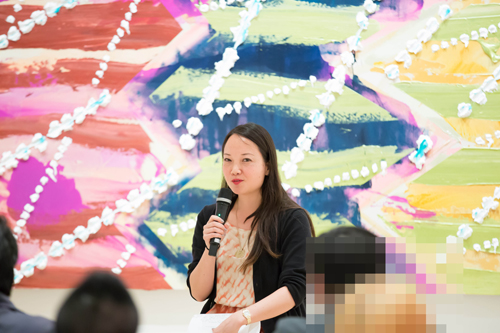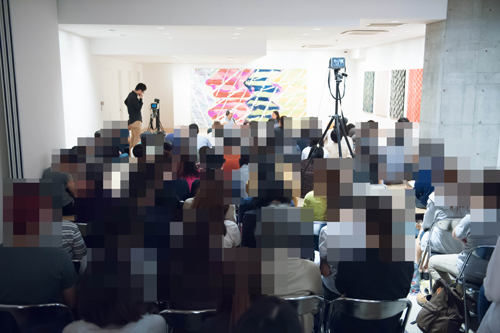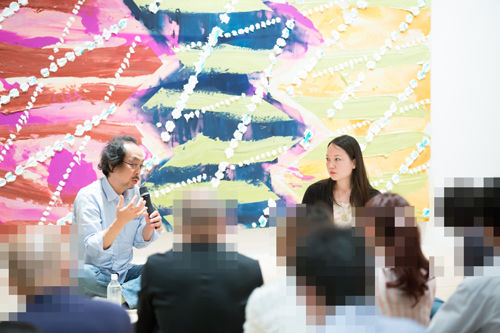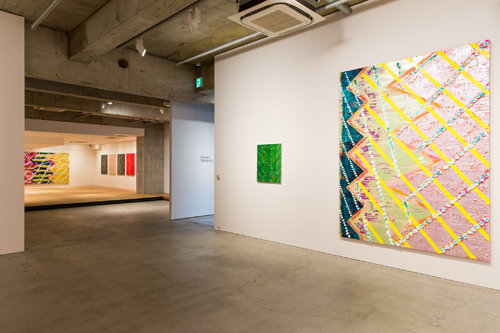News
- 2017/06/09Talkshow: MADSAKI Solo Exhibition, “Here Today, Gone Tomorrow”
- 2016/10/17A Special Exhibition Commemorating the Release of the Catalog for Takashi Murakami’s Superflat Collection
- 2014/12/25Live Talk Report: Aso Kojima x Takashi Murakami
- 2014/09/27Live Talk Report: Kazumi Nakamura x Mika Yoshitake
- 2014/05/27About speech at the Asia Society
- 2013/06/20Exhibition “Takashi in Superflat Wonderland” Opening From July 4
- 2013/06/01Anri Sara, Matthew Monahan participated in the Venice Biennale
- 2013/05/17Kenjiro Okazaki – “Et in Arcadia Ego, The Hidden Place Called “Sculpture”
- 2013/04/16ob x Kazuki Sugawara: Live Performance in conjunction
- 2012/11/30Aya Takano, “Heaven Is Inside Of You”
- 2012/11/30Macy’s Thanksgiving Day Parade
- 2012/10/17Regarding The Temporary Break Period for Kaikai Kiki Gallery Taipei and Hidari Zingaro Taipei
- 2011/10/31Artist Talk by Anri Sala at L’Institut Franco-Japonais de Tokyo
- 2011/10/19Anri Sala x Takashi Murakami Live Talk at Louis Vuitton Japan/ONE Omotesando
- 2011/10/13No Window No Cry (Junzo Sakakura, L’Institut, Institut franco-japonais de Tokyo) on display at L’Institut Franco-Japonais de Tokyo et Yokohama
- 2011/10/06Anri Sala – Concurrent Exhibition at the National Museum Of Art, Osaka
- 2011/06/21google Anniversary logo
Live Talk Report: Kazumi Nakamura x Mika Yoshitake
Recently, we were honored to host a live talk between artist Kazumi Nakamura and Hirshhorn Museum and Sculpture Garden Assistant Curator Mika Yoshitake. That is the same Mika Yoshitake who is also known for curating the group exhibition on Monoha at Blum & Poe Gallery which has lately reignited a boom of interest in post-war Japanese art.
Before the start of the talk, Kaikai Kiki Producer Chiaki Kasahara took a moment to announce the release of a new translation of the contemporary art text “The Medium of Contingency,” which we will make available for purchase in October.
To commemorate the publication, we are also planning a live talk with a young critic who was a recent recipient of Bijutsu Techo’s Art Criticism Award.

Here, Kasahara is pictured holding the original English version of the book. The Japanese translation will be released soon. a
Next, Takashi Murakami stepped forward to introduce the night’s guests. He noted that during preparations for his exhibition ©Murakami at LA MOCA,
Yoshitake served as the right hand of Chief Curator Paul Schimmel, managing matters on site, monitoring the progress of the show, and also curating the merchandise elements.
Murakami then explained that he invited Yoshitake to this night’s event because he wanted her to analyze Nakamura’s art from her objective American-born viewpoint.

Murakami describes his now almost 10 year acquaintance with Mika Yoshitake. b
And then, finally, the evening began. Yoshitake started things off by describing how Nakamura’s former teacher, Koji Enokura, had been a key figure in the Monoha movement, and asking Nakamura how he had been influenced by Enokura’s philosophy and practice. The talk then progressed freely, covering not only developments in the history of Japanese art but also how Nakamura still references the American art history he focused on as a student.

Yoshitake flew all the way from Washington D.C. for this event. c
One of the most talked about aspects of Nakamura’s artistry is the sheer number of works he has produced.
Up until now, he has created over 1000 paintings, a feat which stems from his student-era contemplation of “what it takes to continue creating art over time.”
After studying scores of different artists, he eventually came to realize the importance of developing the theoretical aspects of one’s practice and from this grew several of the series for which he is known. However, Nakamura also discussed how he does not let himself become captured merely by the surface and structural aspects of his work, but also finds ways to connect them to his personal passions.
Listeners came away truly aware of the artist’s vitality.

Nakamura passionately discussed the theories behind his practice. d
At one point, Nakamura turned to the work itself in order to illustrate to the audience how his angular grids were different from the straight-line grids found in paintings abroad.

The audience spread out from the tatami room and included guests who sat on folding chairs in the rear of the gallery. e
Lastly, the conversation turned to a topic of particular interest to Yoshitake, “social semantics,” which was also the title of Nakamura’s exhibition at Hidari Zingaro, and how this relates to abstraction.
Nakamura then explained his belief that abstract art initially stemmed from the social changes that occurred in Europe in the aftermath of World War I and how the abstract style is employed by artists who wish to say “No” to the society of the present and its systems.
Abstract art, he went on, began to decline with the fall of the Soviet Union in the 1990’s but the reason it is reemerging now is again due to our need for a device to voice discomfort with social issues, including the worsening of environmental problems and the widening of the gap between rich and poor.
From American history to social commentary, the audience was fascinated to learn the ways that Nakamura has tied his artistic concepts
to the practicalities of his work. It was a fascinating evening.

The large painting behind our two main guests really seems to be emanating with color and vibrant power. f
A reminder to all that the exhibition will soon come to a close, the last day being Thursday October 2nd.
We hope you will take advantage of this opportunity to see work by an abstract artist who is one of the true singularities of Japanese art history.

The intersecting of color and diagonal lines which defines this space is well worth experiencing for yourself. g
photo
a-f:Teruhiko Fukushima
g :IKKI OGATA